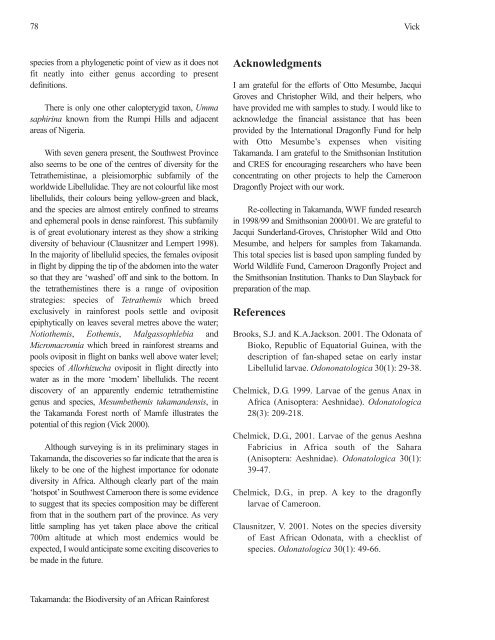Fisheries in the Southern Border Zone of Takamanda - Impact ...
Fisheries in the Southern Border Zone of Takamanda - Impact ...
Fisheries in the Southern Border Zone of Takamanda - Impact ...
Create successful ePaper yourself
Turn your PDF publications into a flip-book with our unique Google optimized e-Paper software.
78<br />
species from a phylogenetic po<strong>in</strong>t <strong>of</strong> view as it does not<br />
fit neatly <strong>in</strong>to ei<strong>the</strong>r genus accord<strong>in</strong>g to present<br />
def<strong>in</strong>itions.<br />
There is only one o<strong>the</strong>r calopterygid taxon, Umma<br />
saphir<strong>in</strong>a known from <strong>the</strong> Rumpi Hills and adjacent<br />
areas <strong>of</strong> Nigeria.<br />
With seven genera present, <strong>the</strong> Southwest Prov<strong>in</strong>ce<br />
also seems to be one <strong>of</strong> <strong>the</strong> centres <strong>of</strong> diversity for <strong>the</strong><br />
Tetra<strong>the</strong>mist<strong>in</strong>ae, a pleisiomorphic subfamily <strong>of</strong> <strong>the</strong><br />
worldwide Libellulidae. They are not colourful like most<br />
libellulids, <strong>the</strong>ir colours be<strong>in</strong>g yellow-green and black,<br />
and <strong>the</strong> species are almost entirely conf<strong>in</strong>ed to streams<br />
and ephemeral pools <strong>in</strong> dense ra<strong>in</strong>forest. This subfamily<br />
is <strong>of</strong> great evolutionary <strong>in</strong>terest as <strong>the</strong>y show a strik<strong>in</strong>g<br />
diversity <strong>of</strong> behaviour (Clausnitzer and Lempert 1998).<br />
In <strong>the</strong> majority <strong>of</strong> libellulid species, <strong>the</strong> females oviposit<br />
<strong>in</strong> flight by dipp<strong>in</strong>g <strong>the</strong> tip <strong>of</strong> <strong>the</strong> abdomen <strong>in</strong>to <strong>the</strong> water<br />
so that <strong>the</strong>y are ‘washed’ <strong>of</strong>f and s<strong>in</strong>k to <strong>the</strong> bottom. In<br />
<strong>the</strong> tetra<strong>the</strong>mist<strong>in</strong>es <strong>the</strong>re is a range <strong>of</strong> oviposition<br />
strategies: species <strong>of</strong> Tetra<strong>the</strong>mis which breed<br />
exclusively <strong>in</strong> ra<strong>in</strong>forest pools settle and oviposit<br />
epiphytically on leaves several metres above <strong>the</strong> water;<br />
Notio<strong>the</strong>mis, Eo<strong>the</strong>mis, Malgassophlebia and<br />
Micromacromia which breed <strong>in</strong> ra<strong>in</strong>forest streams and<br />
pools oviposit <strong>in</strong> flight on banks well above water level;<br />
species <strong>of</strong> Allorhizucha oviposit <strong>in</strong> flight directly <strong>in</strong>to<br />
water as <strong>in</strong> <strong>the</strong> more ‘modern’ libellulids. The recent<br />
discovery <strong>of</strong> an apparently endemic tetra<strong>the</strong>mist<strong>in</strong>e<br />
genus and species, Mesumbe<strong>the</strong>mis takamandensis, <strong>in</strong><br />
<strong>the</strong> <strong>Takamanda</strong> Forest north <strong>of</strong> Mamfe illustrates <strong>the</strong><br />
potential <strong>of</strong> this region (Vick 2000).<br />
Although survey<strong>in</strong>g is <strong>in</strong> its prelim<strong>in</strong>ary stages <strong>in</strong><br />
<strong>Takamanda</strong>, <strong>the</strong> discoveries so far <strong>in</strong>dicate that <strong>the</strong> area is<br />
likely to be one <strong>of</strong> <strong>the</strong> highest importance for odonate<br />
diversity <strong>in</strong> Africa. Although clearly part <strong>of</strong> <strong>the</strong> ma<strong>in</strong><br />
‘hotspot’ <strong>in</strong> Southwest Cameroon <strong>the</strong>re is some evidence<br />
to suggest that its species composition may be different<br />
from that <strong>in</strong> <strong>the</strong> sou<strong>the</strong>rn part <strong>of</strong> <strong>the</strong> prov<strong>in</strong>ce. As very<br />
little sampl<strong>in</strong>g has yet taken place above <strong>the</strong> critical<br />
700m altitude at which most endemics would be<br />
expected, I would anticipate some excit<strong>in</strong>g discoveries to<br />
be made <strong>in</strong> <strong>the</strong> future.<br />
<strong>Takamanda</strong>: <strong>the</strong> Biodiversity <strong>of</strong> an African Ra<strong>in</strong>forest<br />
Acknowledgments<br />
I am grateful for <strong>the</strong> efforts <strong>of</strong> Otto Mesumbe, Jacqui<br />
Groves and Christopher Wild, and <strong>the</strong>ir helpers, who<br />
have provided me with samples to study. I would like to<br />
acknowledge <strong>the</strong> f<strong>in</strong>ancial assistance that has been<br />
provided by <strong>the</strong> International Dragonfly Fund for help<br />
with Otto Mesumbe’s expenses when visit<strong>in</strong>g<br />
<strong>Takamanda</strong>. I am grateful to <strong>the</strong> Smithsonian Institution<br />
and CRES for encourag<strong>in</strong>g researchers who have been<br />
concentrat<strong>in</strong>g on o<strong>the</strong>r projects to help <strong>the</strong> Cameroon<br />
Dragonfly Project with our work.<br />
Re-collect<strong>in</strong>g <strong>in</strong> <strong>Takamanda</strong>, WWF funded research<br />
<strong>in</strong> 1998/99 and Smithsonian 2000/01. We are grateful to<br />
Jacqui Sunderland-Groves, Christopher Wild and Otto<br />
Mesumbe, and helpers for samples from <strong>Takamanda</strong>.<br />
This total species list is based upon sampl<strong>in</strong>g funded by<br />
World Wildlife Fund, Cameroon Dragonfly Project and<br />
<strong>the</strong> Smithsonian Institution. Thanks to Dan Slayback for<br />
preparation <strong>of</strong> <strong>the</strong> map.<br />
References<br />
Vick<br />
Brooks, S.J. and K.A.Jackson. 2001. The Odonata <strong>of</strong><br />
Bioko, Republic <strong>of</strong> Equatorial Gu<strong>in</strong>ea, with <strong>the</strong><br />
description <strong>of</strong> fan-shaped setae on early <strong>in</strong>star<br />
Libellulid larvae. Odononatologica 30(1): 29-38.<br />
Chelmick, D.G. 1999. Larvae <strong>of</strong> <strong>the</strong> genus Anax <strong>in</strong><br />
Africa (Anisoptera: Aeshnidae). Odonatologica<br />
28(3): 209-218.<br />
Chelmick, D.G., 2001. Larvae <strong>of</strong> <strong>the</strong> genus Aeshna<br />
Fabricius <strong>in</strong> Africa south <strong>of</strong> <strong>the</strong> Sahara<br />
(Anisoptera: Aeshnidae). Odonatologica 30(1):<br />
39-47.<br />
Chelmick, D.G., <strong>in</strong> prep. A key to <strong>the</strong> dragonfly<br />
larvae <strong>of</strong> Cameroon.<br />
Clausnitzer, V. 2001. Notes on <strong>the</strong> species diversity<br />
<strong>of</strong> East African Odonata, with a checklist <strong>of</strong><br />
species. Odonatologica 30(1): 49-66.

















